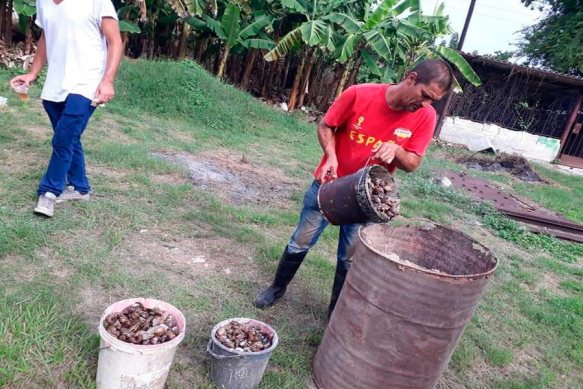Don’t Eat Giant African Snails, Cuban Scientists Recommend
It has also emerged that there are seven animal species which have been identified as natural pest control agents of the plague that is affecting Cuba.

HAVANA TIMES – While some experts have made statements and there is information about the possibility of giant African snails being edible, Cuban academics have recommended that the population not consume this dangerous mollusc because of the risk of becoming infected with other diseases.
At a conference held at the Cuban Academy of Sciences (ACC) on October 24th, malocologist Luis Alvarezhere explained that regardless of the fact that they are edible, the danger lies in them not being cooked properly.
“Most of the fatal cases we have in the world are the result of eating the snail raw. We don’t want that to happen here,” he added.
Meanwhile, he made the point that we don’t all have the culinary expertise to prepare such an exotic dish. “Therefore, we can’t encourage people to consume them because accidents can happen,” he stressed.
Facts about the plague
Giving an update about the current situation in Cuba, Alvarez-Lajonchere reported that the biggest specimens found on the Caribbean island had shells up to 12 cm, when they can grow up to 20 cm.

He also emphasized the high life expectancy of the species which can endure both extremely low and high temperatures in its natural habitat.
Alvarez-Lajonchere warned about the reproductive capacity of this kind of snail, that “can lay eggs up to six times per year.”
“They begin to mate when they reach four or five months old, and they can make approximately 120 eggs in one go. As they grow, they can lay up to 400 eggs in every sitting,” he added.
If you add to this the fact that there is a 95% chance of successful eclosion (survival rate after the egg hatches) and that half of these reach sexual maturity, then their reproduction rates multiply greatly, he pointed out.
Still speaking about reproduction, he stressed that an individual snail can lay up to 1200-1800 eggs in 12 months; a figure which only grows because they can live up to six years, and some of them even nine.
Lajonchere, who is also the curator of the Malocology Collection at the Felipe Poey Natural History Museum belonging to Havana University, explained that urban and suburban areas, gardens and organoponicos (urban organic gardens), are some of the places where the pest was most seen.
“They can be found in the most unimaginable places, even under concrete,” he added.
He also explained that while there hasn’t been any quantifiable evidence of damage caused in agriculture, we have to be on the lookout, because they can cause significant harm in a short period of time.
With this in mind, he said that it was a good thing that cases of the giant African snail have still not been dectected in natural preservation areas such as the Biosphere Reserves and protected areas.
However, he insisted: “We have to stop them from reaching these places because they have the best natural conditions for them to reproduce.”
Natural pest control
For his part, Michel Matamoros, an expert at the state-run Research Institute of Plant Health, spoke about the fact that seven species on the island have been identified as natural pest control agents to counter the giant African snail.
These include three rodents, the hermit crab, some other kinds of snail and birds such as the guirao.

Matamoros also explained that the purchase and sales of snails as decorative ornaments and their use in Yoruba religious rites are reasons for them spreading.
While economic losses haven’t been reported nationwide, Matamoros listed the 17 crops that have been attacked, yucca, pepper, beetroot and watermelon plants being among the most affected.
Up to 52 snails were found per square meter in spots that have been picked for analysis, especially in the Cuban capital. “The population is really quite dense,” he revealed.
In these cases, they can damage up to 50% of a crop, he pointed out.
Both academics insisted on the need for nationwide action and interinstitutional efforts to raise popular awareness about how to contain giant African snails.
Up until now, citizens have organized neighborhood clean-ups, as well as in green areas such as stadiums and school playgrounds, called for by mass organizations, NGOs and state bodies.





